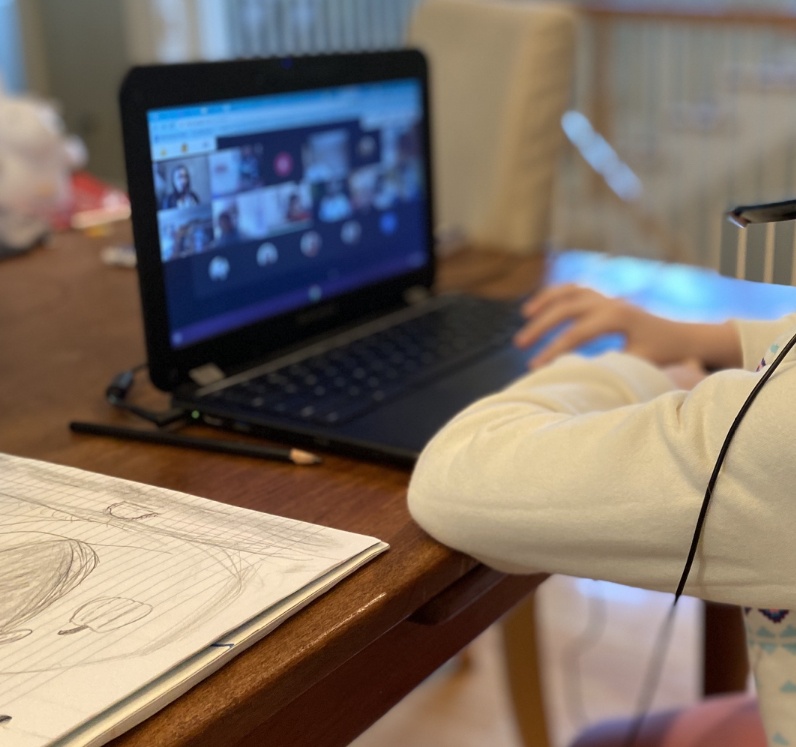Elementary Class Placement Is A “Crazy Science” In The COVID-19 Era

Distance Learning. Photo: Toni Cunningham
Some Pelham and Fort River Elementary Students Have Been Assigned To Remote-learning Classrooms At Wildwood Or Crocker Farm
Michael Morris, Superintendent of Amherst Public Schools, recently described the process of class placement (assigning teachers to students) in the era of COVID as a “crazy science.” With families offered the choice of having their children attend school in-person or remain remote for the foreseeable future, the work of matching children to teachers/classrooms is far more complex than in a typical year.
For kindergarten and first-grade students who were due to begin school in person on October 1 — a start that has now been postponed due to the recent surge in local COVID cases — their caregivers were asked to commit to either in-person or remote learning. That choice was a new variable in making placement decisions, alongside typical variables like children’s needs and their friendship groups. Caregivers of students in grades two through six were also asked for their preference for remote or in-person learning but for those students the choice is not binding at this point since the in-person start date was still a few weeks out.
At a virtual Town Hall event for elementary school families on August 17, Morris confirmed that the District would assign classroom teachers to either teach remotely or in-person, but not both. Morris explained that the two methods use significantly different pedagogical and instructional models, and that it would be very distracting for teachers to try to do both at the same time.
An exception to this is the five “specials” — art, music, library, technology, and physical education — where there is only one teacher for each subject at each school. “Specials” teachers at schools that will have both in-person and remote sections (classes) in each grade, will likely need to teach in both modes every day. Wildwood Elementary School, for example, is slated to have two sections in each grade learning in-person and one learning remotely.
Amherst-Pelham Class Placement
In order to make the model work from a staffing perspective, Morris said the district was looking for Amherst and Pelham to be “collaborators,” and that they would “work within our own staff to find the best teachers to support our students.” What this means in practice is that some students may be assigned to a teacher at a different school than the one they expected to attend. School Committee Chair, Allison McDonald, confirmed to the Indy that only remote students may be assigned to a different school. Students choosing in-person learning will continue at their expected school.
At Pelham Elementary, where there is only one teacher per grade, the six students in kindergarten and grade 1 whose families chose the remote option have been assigned to a teacher at Wildwood or Crocker Farm. Similarly, all ten Fort River students in kindergarten and grade 1 that are not in the dual language program, whose families selected remote learning, have been assigned to a teacher at Wildwood or Crocker Farm. Students in grades two through six may be reassigned to a different school when the time comes for those grades to return in-person.
In response to questions from the Indy on maximum class size, Morris said that the district will follow the School Committee guidance, as much as possible, for remote classrooms. For kindergarten and first grade, the class size guidance is 17-21 students, for second and third grade it is 19-23 students, and for fourth through sixth grades it is 20-24 students.
For in-person schooling, the maximum class size will be determined by classroom space, ensuring six feet distancing between students. If there is insufficient space for all students wishing to attend in-person, Morris said another section would need to be opened. In a recent School Committee meeting, he said that most classes this year have around 20 students or fewer.
Enrollment
Unlike in some rural towns in the northeast, like tiny Winhall Vermont, which saw a 25% increase in enrollment this fall, Amherst’s public elementary schools do not appear to have experienced a significant influx of students fleeing more urban areas because of the pandemic. Enrollment in grades K-6 this fall, across the three elementary schools, is 999 students — a drop of 41 students from last year. This decline is consistent with the trend over the past decade: an average of 19 fewer students have enrolled in Amherst elementary schools each year, although some years saw small increases from a previous year. This school year, there are 126 students in kindergarten, just a slight drop from last year’s 128.
In 2017, a subgroup of the District’s “Enrollment Working Group” was assigned to study declining enrollment. Their report identified a number of factors that were contributing to the decline, including reduced availability of family housing in Amherst due to the increasing pressure from university students, and competition from charter schools, particularly the Pioneer Valley Chinese Immersion Charter School. With the creation of an in-district dual language program at Fort River school in 2019, more families seeking dual language instruction for their children may remain in-district.
At the Amherst Regional Middle School, which draws students from Amherst, Pelham, Leverett, and Shutesbury, enrollment is almost unchanged, from 426 in 2019 to 423 in 2020. At the High School, there is a larger decline of 36 students, from 911 to 875 students. In the 2020-21 academic year, 46 students who would attend grades K-12 are being homeschooled, according to data provided by the district.

1 thought on “Elementary Class Placement Is A “Crazy Science” In The COVID-19 Era”